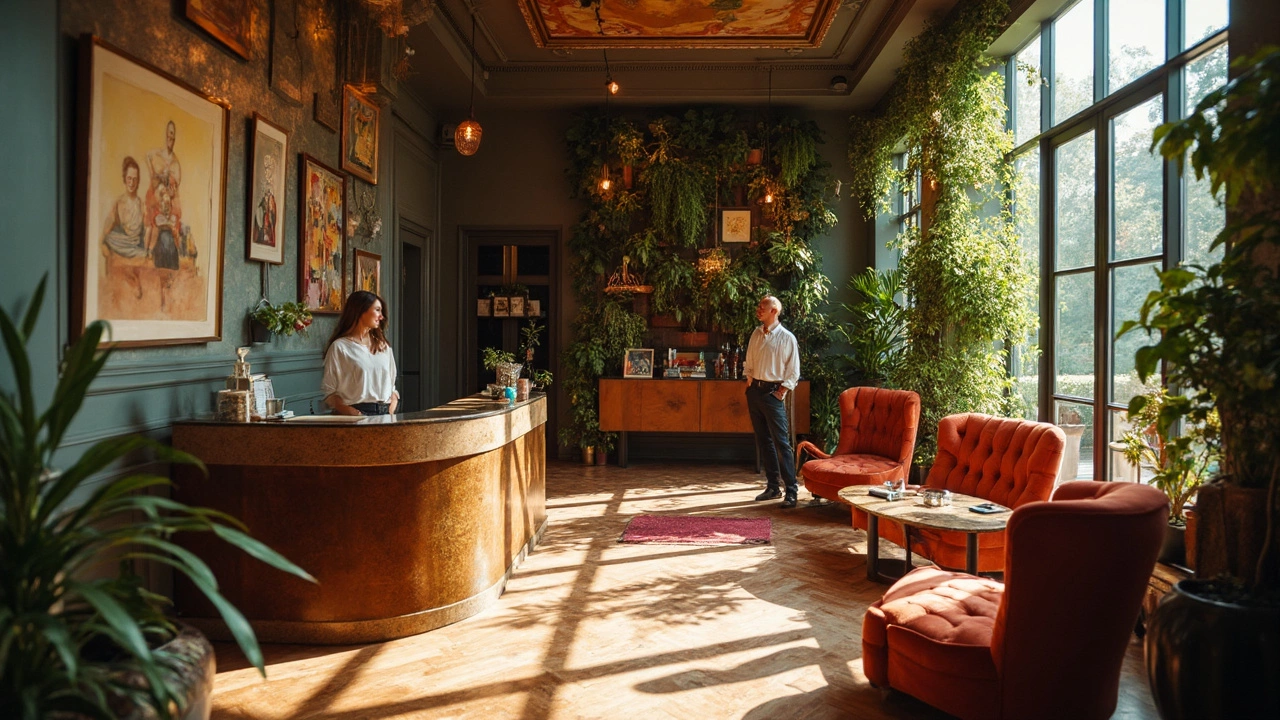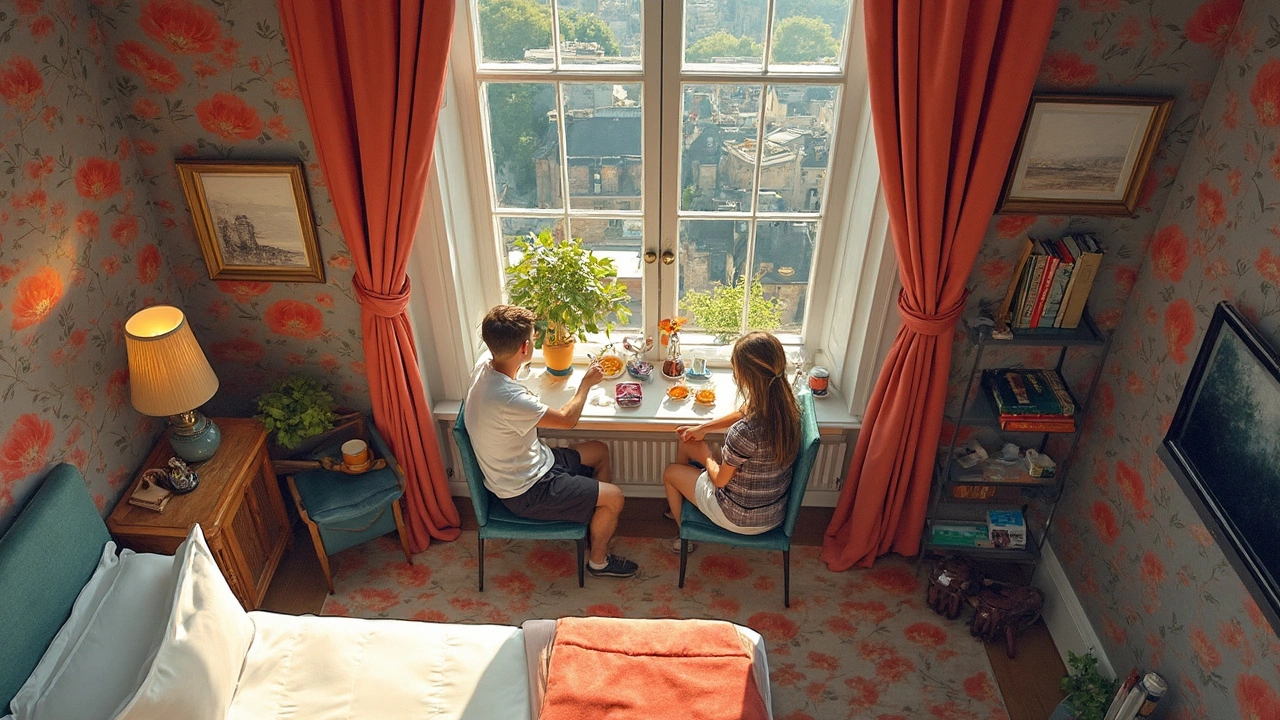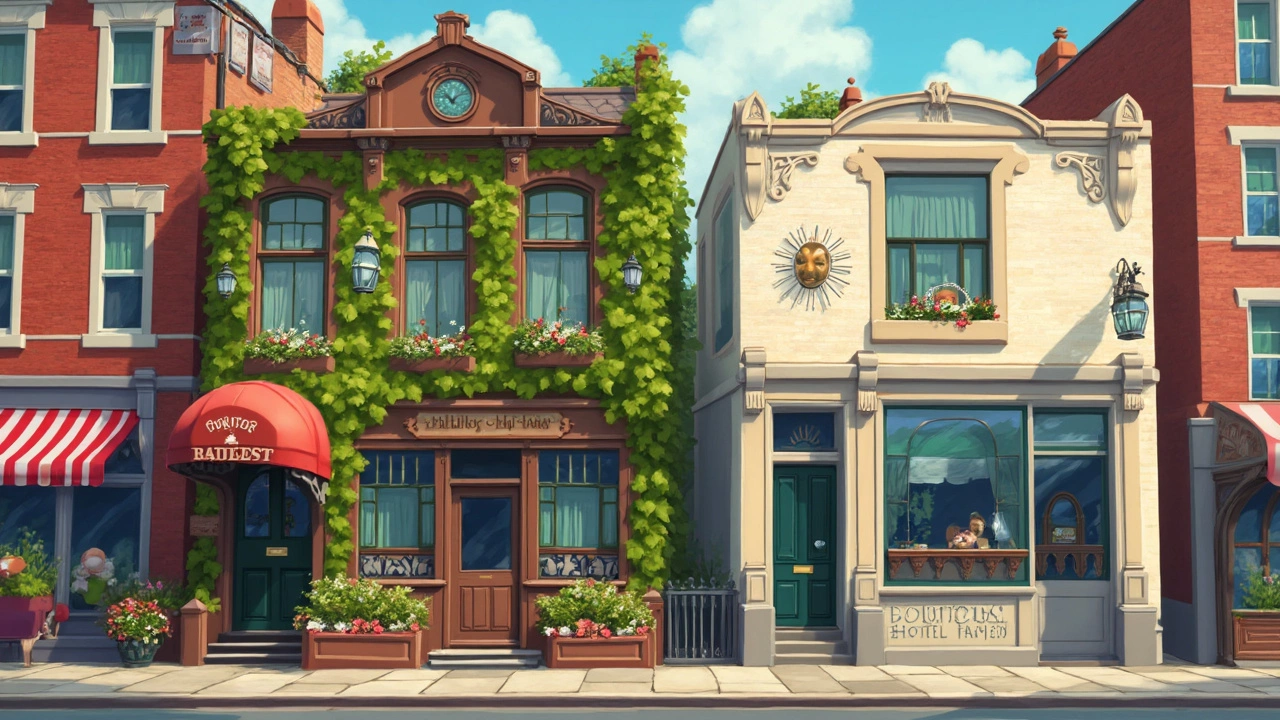Boutique Hotel vs Regular Hotel: What's the Real Difference?

If you’ve ever scrolled through hotel options and wondered why some places call themselves “boutique,” you’re not alone. The word pops up everywhere now, but it’s not just a fancy label. There are some real, concrete differences that set boutique hotels apart from the bigger, well-known brands.
Let’s kick things off with the basics. Regular hotels—think Hilton, Marriott, or even Holiday Inn—follow a set formula. Most of them are part of a large chain. If you know what to expect at one, you’ll find almost the same thing at another, no matter where you go. That can be good for reliability, but not so much for surprises or personality.
Boutique hotels, on the other hand, are all about uniqueness. These places are usually small, often with fewer than 100 rooms, and they’re owned or run independently. If you’ve ever checked into a hotel that felt like it actually belonged in its own city—maybe with local art, funky furniture, or custom scents—you probably just found a boutique hotel.
- Defining Boutique and Regular Hotels
- Size and Scale: Why It Matters
- Design and Atmosphere
- Guest Experience and Services
- Choosing What’s Right for You
Defining Boutique and Regular Hotels
Here’s where things really split. A boutique hotel is a small, individually styled place that usually has between 10 and 100 rooms. These hotels are almost always independent or part of a small local group. You won’t find a standard layout or “cookie-cutter” feel here. Instead, each one is different because owners often take local culture and trends into account when designing everything from the lobby to the breakfast menu.
Regular hotels, on the other hand, are usually run by big chains. Think brands like Marriott, Hyatt, or Best Western. They can have hundreds of rooms—sometimes even over a thousand in the bigger cities—spread across branches all over the world. Policies, room layouts, and basic amenities stay the same from city to city. If you like knowing exactly what you’ll get every time you check in somewhere, these might suit you better.
It’s also about style and service. Boutique hotels focus on giving guests a one-of-a-kind vibe. You might spot locally made art on the walls, custom lighting fixtures, or even get access to neighborhood-only perks like bike rentals or special restaurant deals. If you ask for something offbeat or personalized, many boutique hotels are happy to make it happen because they’re built on personal service and flexibility.
While regular hotels prioritize efficiency and consistency, boutique hotels lean hard into memorable experiences and their own brand of creativity. This doesn’t make one kind better than the other—it’s just a completely different approach. So if you’re deciding where to stay, start by asking yourself: do I want consistency, or do I want something a bit more original?
Size and Scale: Why It Matters
Size isn’t just a number when it comes to hotels—it actually shapes your entire stay. One of the biggest differences between a boutique hotel and a regular hotel is their scale. Most boutique hotels have between 10 and 100 rooms. Regular hotels, especially big chains, often have hundreds—sometimes over a thousand—rooms in one place! That size gap changes everything from how you check in to how much attention you get.
Boutique places feel smaller for a reason. You’re less likely to bump into crowds in the lobby. Staff get to know you by name, sometimes even what you like for breakfast. In a huge chain hotel, it’s easy to feel like another guest on an endless list.
Here’s a quick side-by-side look at typical sizes:
| Type | Usual Number of Rooms |
|---|---|
| Boutique Hotel | 10 – 100 |
| Regular Hotel (chain) | 100 – 2,000+ |
This smaller scale also brings a few perks you’ll actually notice:
- Faster check-in—think minutes, not lines out the door.
- Quieter hallways and common spaces. Perfect for those who value peace.
- Staff who actually remember what you need or like.
But there’s another angle here—big hotels can offer more: multiple restaurants, huge gyms, even ballrooms. If you’re after a classic resort vibe or big group events, a large hotel might suit you better. But if personal service and a calm setting matter more, boutique spots take the win.

Design and Atmosphere
If you’ve ever noticed how some hotels just have a certain “vibe” while others feel kind of cookie-cutter, you’re not imagining things. Design and atmosphere are two of the biggest differences between a boutique hotel and a regular hotel.
Boutique hotels play by their own rules when it comes to looks. They often hire local designers or artists to create one-of-a-kind interiors. For example, the El Cosmico in Marfa, Texas, uses retro trailers and locally crafted furniture, so you get a feel that’s totally different from what you’d find at a chain hotel. Regular hotels, on the other hand, are all about brand consistency—think neutral colors, identical carpets, matching furniture. Walk into a Marriott in Tokyo or Toronto and you’ll probably spot the same framed prints on the walls.
The atmosphere is also a big deal. Boutique spots usually have cozy, homey lounges or quirky bars that attract more than just hotel guests. Staff may greet you by name, and there’s a bigger focus on the community feeling or even putting on art shows and local music nights. Regular hotels try to cater to the masses, so things lean more towards efficiency than personality—think big lobbies, generic playlists, and standardized decor choices.
"Boutique hotels are designed to be experiences, not just places to sleep," says Samantha Brooks, editor at Condé Nast Traveler. "They focus on details that reflect the culture of the area and bring guests an authentic sense of place."
If you’re someone who notices the little things, it helps to look for:
- Original artwork in common spaces or rooms
- Locally sourced furniture or recycled materials
- Custom lighting and mood-setting music
- Unique floor plans, sometimes with rooms that aren’t all the same size or shape
- Cultural or historical references to the city or neighborhood
To back it up, a 2023 study by Statista showed that 68% of travelers under age 40 actually look for unique design or boutique features when booking a hotel. That number’s climbing every year, especially among solo travelers and younger couples.
| Feature | Boutique Hotel | Regular Hotel |
|---|---|---|
| Design Style | Personalized, often local | Standardized across chain |
| Artwork | Original or local art | Mass-produced prints |
| Atmosphere | Community-focused, unique | Uniform, predictable |
| Room Layouts | Varied, non-uniform | Identical layouts |
That’s why the boutique hotel experience often stands out. If you want a stay that actually feels memorable or “Instagram-worthy,” this is where you find it.
Guest Experience and Services
This is where things get interesting, because your time inside a boutique hotel feels way different from a stay at a standard chain. In boutique hotels, the staff usually know your name, remember your coffee order, and even give tips about secret local spots. You’re not just another key card—guests often get personal attention you won’t find at chains.
Boutique hotels also throw in unique touches. You might find homemade cookies at check-in, curated playlists in your room, or complimentary wine hours in the lounge. Some spots feature workshops with local artists, free yoga, or bikes you can borrow to explore the neighborhood. The idea is to help guests feel part of the local vibe, not stuck in a hotel bubble.
Chain hotels, meanwhile, focus on consistency and reliability. Room service, gym access, a pool, and a breakfast buffet are the standard basics. Staff are trained to make sure everyone gets the same level of service no matter where in the world you’re staying. While there’s usually lots of convenience, the experience is more generalized and less personal.
- Boutique hotels often offer locally sourced bathroom amenities (think artisan soap or shampoo from nearby makers).
- Many provide extra services like in-room spa treatments or custom city guides written by staff who actually live in the neighborhood.
- Some boutique spots will customize your room pre-arrival, adjusting lighting, scents, or snacks based on your preferences.
Here’s a quick look at some service differences between the two:
| Service Feature | Boutique Hotel | Regular Hotel |
|---|---|---|
| Personalized Service | High (staff remember preferences) | Moderate (standardized approach) |
| Local Experiences | Common (city guides, events) | Rare |
| Room Customization | Available in top-tier boutiques | Not typical |
| Loyalty Programs | Usually not, or more unique perks | Big brands with points and rewards |
| Atmosphere | Intimate, unique, themed | Consistent, familiar |
If service matters most to you, and you like surprises, boutique hotels are worth the splurge. But if you want predictable basics and points to use later, chains might fit better. Decide what kind of stay actually makes you feel comfortable and cared for.

Choosing What’s Right for You
So you’re at the point of booking and torn between a boutique hotel and a regular hotel. Here’s the deal: each comes with its own perks and drawbacks. Let’s figure out what matters most for your trip.
If you’re after a unique setting, more personalized attention, and a real sense of the local vibe, boutique hotels are the way to go. These spaces are usually curated right down to the last pillow, and staff tend to remember your name—not just your room number. But, rooms tend to be limited, and amenities like gyms or pools might not be as grand as what you’d see at a big chain.
On the flipside, regular hotels bring predictability. You usually get 24/7 check-in, reliable housekeeping, loyalty rewards, and often bigger facilities. If you’re traveling for business, or with kids, the consistency and extra services can be a real lifesaver. Plus, big brands tend to have more locations worldwide, so it’s easier to earn points and score upgrades.
- Value local flavor? Boutique hotels have more personality and often offer tips you won’t find online.
- Want loyalty perks, or are you racking up points? Go with a chain.
- Is budget the final decider? Boutique hotels can cost more, but not always. Mid-range boutique spots do exist, especially outside city centers.
- Need wheelchair access, a big gym, or 24/7 room service? Check these details—boutique hotels can be hit-or-miss on that front.
Here’s a quick data breakdown so you can see the main differences at a glance:
| Feature | Boutique Hotel | Regular Hotel |
|---|---|---|
| Typical Room Count | 10–100 | 100–1000+ |
| Design | Unique/local | Standardized |
| Loyalty Programs | Rare | Common |
| Average Price/Night (US Urban) | $140–$350 | $120–$280 |
| Amenities | Varied; sometimes limited | Consistent; broad |
One simple tip: if you’re not sure, check the reviews and look for mentions of staff, breakfast, or atmosphere. Travelers almost always mention these in boutique hotels. For big chains, people focus more on convenience and amenities.
Pick the one that fits your style. There’s no universal “better”—it’s all about what you want from your stay.